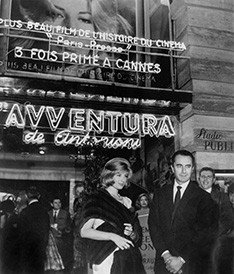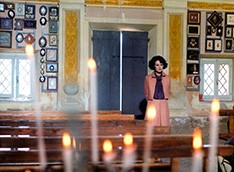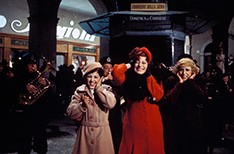A literary and cultural giant whose influence can be seen in many aspects of our rapidly evolving media, Umberto Eco (1932 – 2016) produced a critical oeuvre that remains important to the study of cinema. Throughout decades of interdisciplinary writing, Eco seamlessly moved between academic work, semiotic analysis, acclaimed novels, and more informal cultural commentary, leaving indelible marks on each area. Eco once explained his approach as concerned “with the problems of language, communication, organization of the systems of signs that we use to describe the world and to tell it to one another,” acknowledging the relationship between his own work and the field of semiotics [2]. A tracing of Eco’s theories inevitably recounts the history of cinema and reveals a mutual development. The film series at the National Gallery of Art illustrates the inextricable link between his work and its subject matter, as the cinema itself was informed and challenged by his theoretical approach while also enriched by his contributions.
Although his direct encounters with filmmaking were fleeting — among them a near screenwriting collaboration with Michelangelo Antonioni — Eco was, among many other innovative roles, a founding father of film semiotics, a discipline propelled forward in a series of memorable debates at the Mostra Internazionale del Nuovo Cinema in Pesaro from 1965 to 1967. These discussions, which also featured Pier Paolo Pasolini, Christian Metz, and Roland Barthes, among others, inaugurated a new chapter of theoretical and critical perspectives on the nature and development of a film language and, in retrospect, offered a new approach by which to study the works emerging during that decade and beyond.
Ipersignificato
Ipersignificato: Umberto Eco and Film

Monica Vitti and Michelangelo Antonioni, Paris premiere of L'Avventura, 1960, courtesy Janus Films/Photofest.
"The universe of action depicted by the cinema is already a universe of signs."— Umberto Eco, “sulle articolazioni del codice cinematografico” [1]
Amarcord and Teorema
Eco was also a prolific and vigorous commentator on works of popular culture, rigorously treating them as cultural artifacts whose narrative structures, aesthetic components, and semiotic elements warranted insightful study. His work on these topics is fundamentally engaged in the dynamics of cultural expression, and his pronounced involvement in the field of semiology is informed — certainly in his observations on film — by an inquisitiveness toward modes of cultural communication. In this light, cinema is a code with a “triple articulation,” as Eco argued, resulting in a “heightened expressiveness” in the transition from written or spoken word to cinematic language; if language is traditionally a pragmatic solution through which meaning is inevitably impoverished, the moving image allows us to reclaim some of that meaning, a result the writer would refer to as ipersignificato. [3]

Still from Teorema, courtesy Photofest.
The films presented in the Gallery’s series distill Eco’s work and map his critical footsteps, following a loose chronology that illustrates the development of the theory and practice of filmmaking over the past century, while noting the progressive awareness of what a language of film has the potential to be. As a result, the selection does not adhere to any one type of relationship with Eco, instead offering varying links to the writer and his work; some of the films act as important contextual pieces, as is the case with Teorema, while others represent case studies with an added personal connection, such as Casablanca and Stagecoach. His influential theory of the open work is at the center of the series, providing a frame of reference for the other films while scrutinizing cinematic language as part of a larger aesthetic question. Finally, the trajectory arrives at a self-reflexive moment, in which the culture created by cinema becomes an active entity in and of itself, encapsulating Eco’s later interest in postmodern aesthetics.
"If we can’t manage to get ahold of it, that doesn’t mean that there’s no code at all, but rather that it still has to be found." — Umberto Eco, “articulations of the cinematic code” [4]
The inception and first developments of semiotics in cinema were marked by a central problematic of language. Evolving from the groundwork laid out by linguistics — certainly in its application of the tools forged by Barthes and Ferdinand de Saussure — the discipline in the late 1960s was in need of an academic and theoretical independence. Seeking to identify a series of codes and languages inherent to the cinematic medium was essential to the perception of film as a truly distinct mode of expression. Eco urged an understanding of film that moved away from the parameters of the word, considering semiotics to be “neither a province nor a byproduct of linguistics,” and allowing the image to become the primary focus of discussion. [5]
Of even greater influence, however, was Eco’s position on the signifying qualities of the captured image. The debate on cinematic articulation underlined a tension between the naturalism and arbitrariness of iconic signs, and by definition the film frame, and the meanings images carry based on cultural conventions. This friction was at the center of an extended dialogue between the two polarized voices of Eco and Pier Paolo Pasolini. Pasolini, as both theorist and artist, firmly believed cinema to be the “written language of reality,” [6] a direct record of the real world that, in capturing the language of action via images and sound, is able to express reality like no medium before it. Life itself, according to Pasolini, is a continuous, living film, and cinema’s role is to reproduce it without mimicking it, therefore obliging us “to broaden our notion of language.” [7]

Still from Armacord, courtesy New World Pictures/Photofest.
This position invited much skepticism. Eco offered the most rigorous response, refuting Pasolini’s arguments while acknowledging the general appeal of his notions. In “Articulations of the Cinematic Code,” a transcript of ideas outlined at the Pesaro conventions, Eco’s vision comes to the forefront in his critique of Pasolini’s theory [8]. Rejecting the view of film as unburdened from cultural convention, the writer underlines the very richness that is a result of cinema’s freedom from translating such a reality as Pasolini suggests. Eco notes that the universe that the cinema depicts “is already a universe of signs,” and, far from transcribing an analogous, spontaneous reality, the cinema generates instead a codified language of culturally obtained meanings that has strong implications for the real world. If Pasolini equates the language of film to that of reality, Eco argues for cinema’s own complex construction that operates within an amplified system of meaning; in the semiotic debate of articulation, his proposition of a triple articulation in this sense endows the medium with poetic signifying qualities [9].
As Eco continued to expand on cinema’s semiotic traits, he praised Federico Fellini as a director who “lived to redeem the cinema from what is external to it.” The external, in the eyes of Eco, is precisely what Pasolini embraced — reality. As perhaps the utmost exponent of hyperrealism on film, Fellini and his oeuvre seem to negate the restrictions imposed on the material world, instead lending form to and exalting that which is internalized and, in the process, generating an “art of memory.” This memory, then, is precisely what Eco celebrates in his dissection of Fellini’s role in the cinematic landscape [10].
Amarcord (1973), in this regard, marks the pinnacle of Fellini’s exploration of his personal history, and it is no surprise that Eco elects the film, which puts the “reconstruction and invention of memory” at the forefront, as a synthesis of the director’s work as a whole. More of a loose reminiscence than any grounded re-creation of Fellini’s youth, Amarcord serves as something of an artist statement for the later portion of his career, a work whose form is molded by the very process of its creation, one which evades any external convention or pretext and is instead driven solely by the saturated and distorted fragments of memory, which, in becoming cinematic signs, take on a new life entirely [11].
The pairing of Amarcord with Teorema (1968), a product of Pasolini’s artistic stance of the time released shortly after the Pesaro conventions, presents a theoretical dichotomy reflected in the tone of the films. Teorema has a bold social perspective, but it embodies an artistic philosophy manifested in the film’s concern with layered consciousness and realities, constantly shaking any objective or subjective gaze we might seek within its frames.
[1] Umberto Eco, “Sulle Articolazioni del Codice Cinematogra” in Per una nuova critica: I convegni Pesaresi, 1965 – 1967, Nuovocinema/Pesaro 33 (Venice, 1989), 401. (back to top)
[2] Umberto Eco, Travels in Hyperreality (San Diego, 1986), x. (back to top)
[3] Eco uses this term — which translates to “hypermeaning” — in a way that is analogous with hyperspace to convey that which transcends our Euclidian parameters of geometry and, here, the barriers and limitations of communication. Eco, “Sulle Articolazioni del Codice Cinematogra co,” 409. (back to top)
[4] Umberto Eco, “Articulations of the Cinematic Code,” in Movies and Methods: An Anthology, ed. Bill Nichols, vol. 2 (Berkeley, 1985), 592. (back to top)
[5] Umberto Eco, “On the Contribution of Film to Semiotics,” Quarterly Review of Film Studies 2, issue 1 (1977): 231. (back to top)
[6] Pier Paolo Pasolini, “The Written Language of Reality,” in Heretical Empiricism, by Pier Paolo Pasolini and Louise K. Barne (Bloom- ington, 1988), 197 – 222. (back to top)
[7] Oswald Stack and Pier Paolo Pasolini, Pasolini on Pasolini: Interviews with Oswald Stack(Bloomington, 1969), 29. (back to top)
[8] Eco in Nichols, 590 – 606. (back to top)
[9] Eco in Nichols, 604. (back to top)
[10] Umberto Eco, “Thoth, Fellini and the Pharaoh,” in Perspectives on Federico Fellini, by Peter E. Bondanella (New York, 1993). (back to top)
[11] Eco describes this process as the continuous translation of “words into icons, icons into ostensive signs, ostensive signs into new definitions.” Umberto Eco, A Theory of Semiotics(Bloomington, 1979), 71. (back to top)
The National Gallery of Art’s film program provides many opportunities throughout the year to view classic and contemporary cinema from around the world.
View the current schedule here.
